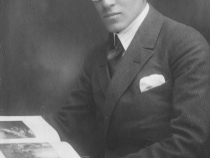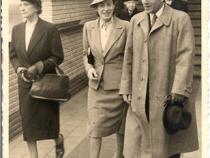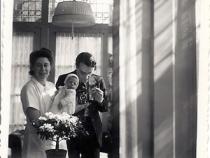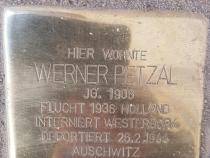Werner Petzal was born on 11th November 1906 in Berlin. He attended the Kirschner Oberrealschule nebst Realgymnasium F.S. in Berlin. The Petzals were a conventionally traditional family rather than a religious one but even so both sons were Barmitzvah at the Liberal Fasanen Street Synagogue and attended the Religionschule der Jüdischen Gemeinde zu Berlin at NW 21, Bochumer Strasse 8. Werner then studied law and became a Human Rights lawyer. He was a lively and gregarious young man who loved to travel and act in amateur dramatics as seen in many photographs. There is evidence that Werner went to Spain in 1934 and was still there in 1936, working for the Civil War effort. Werner tried extensively to look for a place of safety away from Germany applying for passports for Mexico and China. In 1937 Werner went to the Netherlands to look for a place of safety for his family and was followed by his mother and his wife Fanni Betty Oppenheimer. Their son Bernhard Wolfgang Petzal was born in 1942 in Hilversum in the Netherlands where they lived until 1942, first on the coast and then sheltered by the Dutch Hummeling Family at 5, Pieter den Hoogh Straat in Hilversum, near Amsterdam. In February 1942 the family were betrayed to the Gestapo and sent to Camp Westerbork in the north of Holland.
Westerbork is best known as the transit camp where Anne Frank and her family were sent prior to their deportation to Auschwitz.Westerbork was intended as a model camp, to function on the surface like a village. There were courses to follow, sports to play, a kindergarten and school. On Tuesday nights, there were revues, concerts and plays in the registration barrack. The Westerbork camp had a ‘double life’. While most inmates stayed for a short period before being deported, there was also a more permanent camp population of 2,000 people, mostly German Jews, Jewish council members, camp employees, and others, all temporarily exempt from deportation. Werner and his family appeared to be in this category. In her diaries, Etty Hillesum described that ‘Dr. Werner Petzal led the so called ‘application centre’ from July 1942 which provided new arrivals with information about the possibilities of postponing transport elsewhere’. Werner also features in a book with drawings of the camp by Leo Kok.
There was a hospital with decent medical care in Westerbork, and it was here on 10th August 1943 that Fanni gave birth to twins, Robert and Elisabeth. So many Jews were surgeons, doctors or dentists and a job in the hospital so coveted, (delaying transportation) that highly skilled staff could be selected. At one time, the hospital had 1,725 beds, 120 doctors and 1,000 staff members.
From October 1942, the organization of Camp Westerbork was in the hands of SS-Obersturmführer Gemmeker. Outwardly calm, polite and correct, Gemmeker was skilled at flawlessly implementing Nazi plans. His overriding concern was to meet the quota for the number of Jews deported every week. A Jewish police unit kept order and assisted with the transportations.
From Camp Westerbork, from July 1942 until September 3rd, 1944, 93 trains departed in the direction of the camps in Eastern Europe, deporting 97.776 Jews to almost certain death.
In the end, most of the permanent inmates were also sent to the concentration and death camps and Werner, his mother Selma, his wife Fanni and three small children were sent to Theresienstadt 25th February 1944. Werner is listed as being part of what was known as ‘The University over the Abyss’ at Theresienstadt . He was deported from there on 16th October 1944 and died at Fürstengrube 27th January 1945. My father was told, that as the Germans were retreating from the camp in the face of the advancing Russians, they threw grenades. The grenade that killed his brother Werner blew off the fingers of the man who later told him this story.








